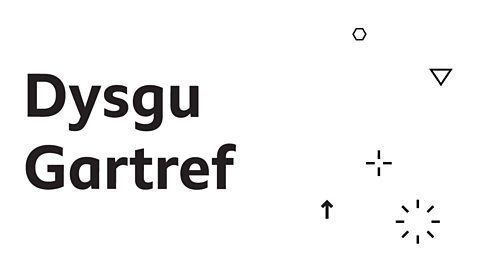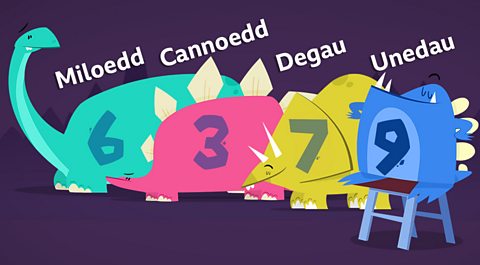
Ffocws dysgu
Dysga ddarllen ac ysgrifennu rhifau hyd at 1 filiwn.
Mae'r wers hon yn cynnwys:
- ffeithiau am werth lle
- gwybodaeth am dermau gwrywaidd a benywaidd wrth ymwneud Ć¢ rhifau
- dau weithgaredd
Learning focus
Learn to read and write numbers to 1 million.
This lesson includes:
- facts about place value
- information on feminine and masculine terms regarding numbers
- two activities

Gwerth lle
Rydyn niān defnyddio penawdau gwerth lle fel 10, 100 a 1,000. Maeār rhain yn ein helpu i wneud symiau a gweld pa rifau syān fwy naāi gilydd.
Place value
We use place value headings like 10, 100, 1,000. These help us do sums and see which numbers are bigger than others.

Yn y rhif 3,147,286, gwerth y rhif 2 yw 200 (dau gant) a gwerth y rhif 3 yw 3,000,000 (tair miliwn).
Edrycha ar y rhifau i gyd i weld beth yw gwerth pob un.
In the number 3,147,286, the value of the number 2 is 200 (two hundred) and the value of the number 3 is 3,000,000 (three million).
Look at all the numbers to see the value of each one.


Ysgrifennu a dweud rhifau
Wrth ddweud rhifau cyfan, cofia werth lle'r digidau gwreiddiol.
Yn y Gymraeg mae dwy ffordd o ddweud rhifau ar Ć“l 10. Yn draddodiadol, ac wrth gyfeirio at ddyddiadau ac amser, fel arfer rydyn niān dweud:
- un ar ddeg
- deuddeg
- tri ar ddeg
- pedwar ar ddeg
- pymtheg
- un ar bymtheg
- dau ar bymtheg
- deunaw (ac nid tri ar bymtheg)
- pedwar ar bymtheg
- ugain
Maeār dull hwn o rifo yn parhau wedyn fesul ugain.
Writing and describing whole numbers
When describing whole numbers, remember the place values of the original digits.
In Welsh, there are two ways of saying numbers after 10. Traditionally, and in referring to dates and time, usually we say:
- un ar ddeg (eleven)
- deuddeg (twelve)
- tri ar ddeg (thirteen)
- pedwar ar ddeg (fourteen)
- pymtheg (fifteen)
- un ar bymtheg (sixteen)
- dau ar bymtheg (seventeen)
- deunaw (not tri ar bymtheg) (eighteen)
- pedwar ar bymtheg (nineteen)
- ugain (twenty)
This method of counting then continues in intervals of twenties.

Geiriau benywaidd a gwrywaidd
Ar ben hyn mae gyda ni eiriau ar gyfer niferoedd benywaidd a gwrywaidd. Felly:
- dwy ferch
- tair dynes
- pedair gwraig
- dwy ferch ar bymtheg (ar gyfer 17 merch)
Mae patrwm diddorol wrth ddisgrifio amser:
- tair eiliad
- tri munud
- tair awr
- tri diwrnod
- tair wythnos
- tri mis
- tair blynedd
Fel arall rydyn niān defnyddio ffordd fwy uniongyrchol o ddweud y rhifau.
Er enghraifft, rydyn niān dweud 'un deg dau' am 12, ac mae gwerth lle y digidau yn amlwg.
Felly hefyd gyda ātri chant dau ddeg a nawā ar gyfer 329. (Cofia mai 12 ydy ādeuddegā, ac mai 20 ydy ādau ddegā).
Yn yr un modd, mae colofnauār miloedd, y degau o filoedd aār cannoedd o filoedd fel arfer yn cael eu disgrifio gydaāi gilydd.
Dyma enghreifftiau:
| Rhif | Dywedwn |
|---|---|
| 7,000 | saith mil |
| 67,000 | chwe deg saith mil |
| 167,000 | cant chwe deg saith mil |
Enghraifft
Gallwn ni ysgrifennuār rhif 3,147,286 mewn geiriau fel hyn:
tair miliwn, cant pedwar deg saith mil, dau gant wyth deg a chwech
Masculine and feminine words
In addition to this, we have feminine and masculine words. eg:
dwy ferch (two girls/daughters)
tair dynes (three women)
pedair gwraig (four women)
dwy ferch ar bymtheg (seventeen girls/daughters)
There is an interesting pattern describing time:
- tair eiliad (three seconds)
- tri munud (three minutes)
- tair awr (three hours)
- tri diwrnod (three days)
- tair wythnos (three weeks)
- tri mis (three months)
- tair blynedd (three years)
Otherwise, we use use a more direct way of saying numbers.
For example, we say 'un deg dau' for 12 where the place value of the digits is obvious.
Also with ātri chant dau ddeg a nawā for 329, remember that 12 is 'deuddeg' and that 20 is 'dau ddeg'.
In the same way, the thousands columns, the tens of thousands and the hundreds of thousands are usually described together.
Here are some examples:
| Number | We say |
|---|---|
| 7,000 | saith mil (seven thousand) |
| 67,000 | chwe deg saith mil (sixty seven thousand) |
| 167,000 | cant chwe deg saith mil (a hundred and sixty seven thousand) |
Example
We can write the number 3,147,286 in words like this:
tair miliwn, cant pedwar deg saith mil, dau gant wyth deg a chwech
(three million, one hundred and fourty seven thousand, two hundred and eighty six)

Gweithgaredd 1 / Activity 1
Edrycha ar y rhif isod ac ateba'r cwestiynau.
Look at the number below and answer the questions.
3,124,687
- Beth yw gwerth y rhif 8? / What is the value of the number 8 ?
- Beth yw gwerth y rhif 3? / What is the value of the number 3?
- Beth yw gwerth y rhif 1? / What is the value of the number 1?
- Beth yw gwerth y rhif 7? / What is the value of the number 7?
- Beth yw gwerth y rhif 2? / What is the value of the number 2?
- Beth yw gwerth y rhif 4? / What is the value of the number 4?

Gweithgaredd 2 / Activity 2
Ysgrifenna'r rhifau isod mewn geiriau.
In Welsh, write the numbers below in words.
- 4,235,225
- 7,369,890
- 3,521,472
- 2,321,989
- 8,458,345

Nodiadau i rieni
Ar ddiwedd y wers bydd disgyblion:
- yn gwybod beth yw unedau, degau, cannoedd a miloedd
- yn gallu darllen rhifau mawr hyd at filiwn
- yn gwybod bod gwerth lle yn ein helpu ni i gyfrifo beth yw gwerth digid yn dibynnu ar ei safle yn y rhif
Notes for parents
At the end of the lesson, pupils will:
- know what units, tens, hundreds and thousands are
- be able to read big numbers up to a million
- know that place value helps us calculate the value of a digit depending on its position within a number

Hafan “óĻó“«Ć½ Bitesize
Gwyddoniaeth, Saesneg, Hanes a mwy - mae popeth yma i ti

Cynnwys y tymor hwn
Fideos, cwisiau a gweithgareddau i dy gefnogi yn ystod y tymor hwn

TGAU
Canllawiau dysgu i'r rhai ym mlwyddyn 10 ac 11
